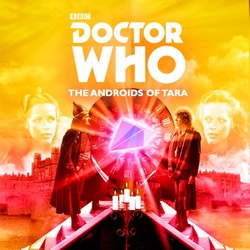Doctor Who meets the Loch Ness Monster. I mean, what nine year old boy wouldn’t want to see that? So you can imagine my frustration that it was a further ten or so years before my dad finally found a VHS copy of Terror of the Zygons in a second-hand bookstore. (Should you ever find yourself in Northern Ireland I highly recommend popping in for a visit!)
What was extraordinary is that despite the excitement of seeing the exciting shape-shifting Zygons, and wanting to see Harry’s last adventure as a Doctor Who regular, it took about three watches for me to appreciate the story. Perhaps it was due to the video itself being extremely worn out, and being an omnibus presentation – I certainly know that I enjoyed the adventure much more when the episode breaks were reintroduced.
The story itself is a wonderful straightforward adventure that Jon Pertwee himself could have played with aplomb. The Doctor is summoned back from his preceding adventure by the Brigadier, who is investigating mysterious attacks on Scottish oil rigs. While the story was originally constructed around the mythology surrounding the Loch Ness Monster, the genius of the story was to have the monster be the cyborg servant of an invading alien force – the titular Zygons. Shape-shifting beings who are able to take on the appearance of others, these aliens would prove so popular they would be brought back, largely at David Tennant’s request, to feature in the fiftieth anniversary special The Day of the Doctor, before earning their own double-part story in Season 9. The revelation of the Zygon menace at the end of episode one, surely has to rank as one of the greatest cliffhangers in Doctor Who history.
The story features many other pleasing touches – whether it is the Doctor and Brigadier donning Scottish attire, to the performances by the Zygons and their duplicates. The duplicity of the Zygon doubles enables the production team to deliver a combination of pace, suspence, and atmosphere, with an ease that belies its difficulty. At no point does the adventure feel pedestrian, with the only slight drawback being the realisation of the monster; although remembering the production budget of 1970s Doctor Who, the Skarensen is really not that badly presented!
A final note relates to where this story sits within the Tom Baker era. Although filmed and produced with the other stories from Season 12, the story was held back to lead Season 13, enabling the production crew to shift the series’ start from the traditional January slot to September. The story undoubtedly has an uneasy feel as a result; while it feels more akin to Baker’s debut adventure Robot it is also true that Harry plays a much less prominent role compared to other season 12 adventures. I think I prefer to think of Terror of the Zygons as the last story of Season 12; and also that Harry deserved a much better send off than telling the Doctor he preferred to take the train to London!
Next time: I introduce a three-part special of reviews …


